32 fascinating photos of one of the world's largest bird collections that the public will never see
Michelle Yan Huang,Nicole Raucheisen

Drawers of birds and Smithsonian scientist Roxie Laybourne at the Smithsonian National Museum of Natural History.Chip Clark/Smithsonian National Museum of Natural History
- The Smithsonian National Museum of Natural History has a collection of 600,000 preserved birds.
- They're stored in aisles of drawers in the Bird Division at the museum, inaccessible to the public.
I went behind the scenes at the Smithsonian Museum, which privately stores over 600,000 preserved birds.
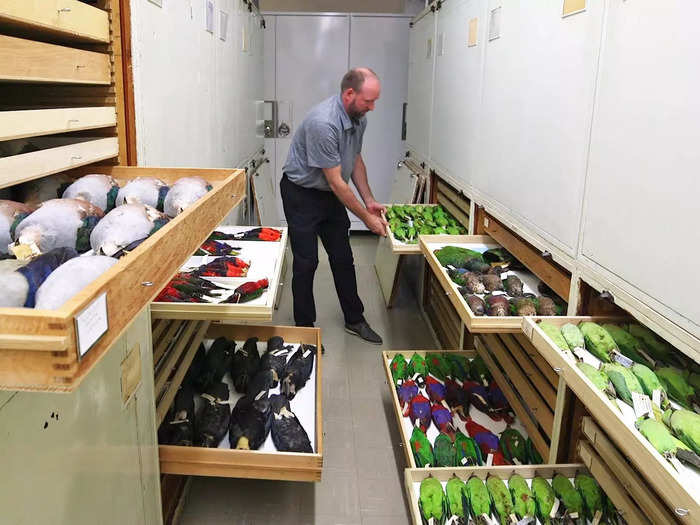
Collections Manager Chris Milensky shows the Bird Division's skins collection at the Smithsonian National Museum of Natural History. Michelle Yan Huang/Insider
This bird collection is one of the largest in the world. It's often used for research and identifying birds involved in airplane accidents.

A drawer of blue-cheeked bee-eater birds at the Smithsonian National Museum of Natural History. Michelle Yan Huang/Insider
The collection includes seven categories: mounted birds, skins, skeleton, fluid, eggs, nest, and genetics.
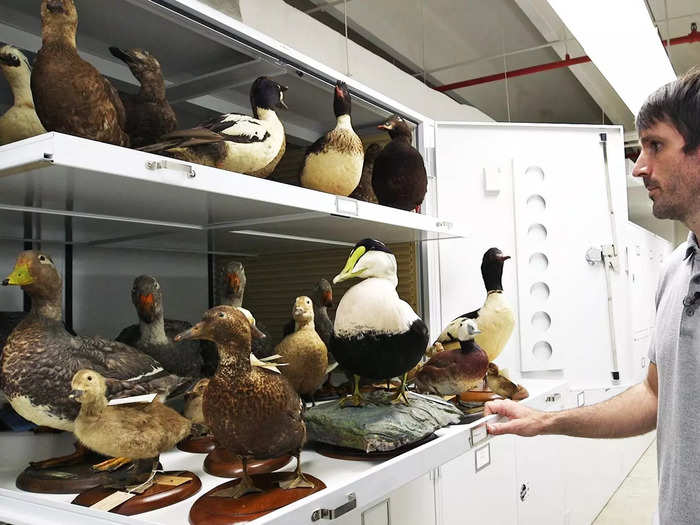
Museum specialist Jacob Saucier walking me through the mounted bird section. Michelle Yan Huang/Insider
Mounted birds are taxidermied for exhibit display. When they retire, they're stored here away from pests, dust, and light, which would cause colors to fade.

A chick that was previously on display at the Smithsonian National Museum of Natural History. Nicole Raucheisen/Insider
This huge bustard bird is one of the heaviest flying birds in the world. An average adult male weighs 30 pounds.
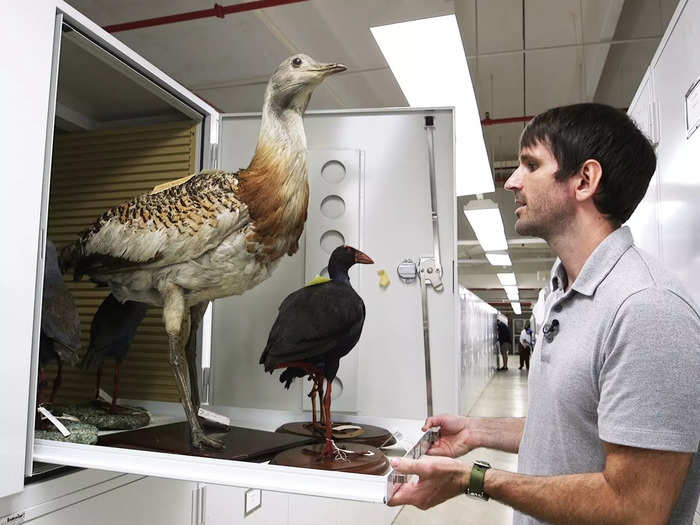
A mounted bustard bird specimen at the Smithsonian National Museum of Natural History. Michelle Yan Huang/Insider
Since real eyeballs don't preserve well and can attract pests, these unblinking eyes are made of glass.
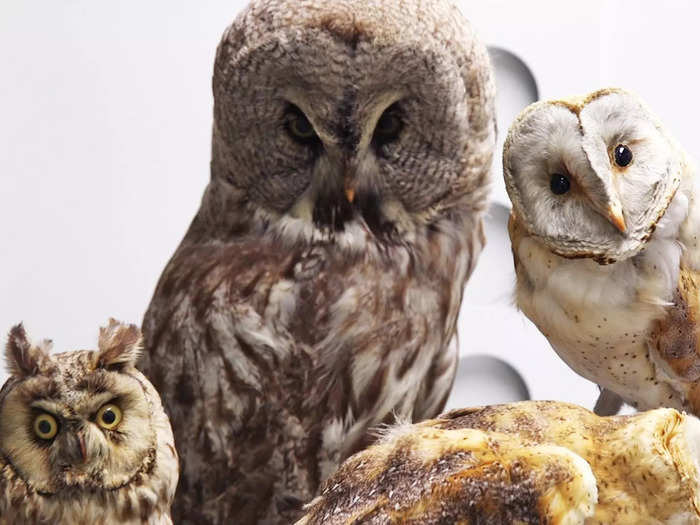
From left to right, a long-eared owl, a great grey owl, and two barn owls at the Smithsonian National Museum of Natural History. Nicole Raucheisen/Insider
These macaws, found in tropical America, have been taxidermied. Feathers retain their color, but the birds may need glass eyes and paint touch-ups.
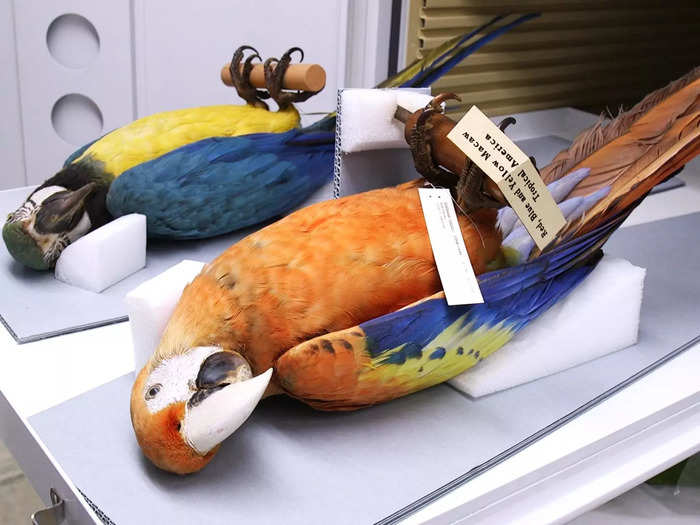
A blue-and-yellow macaw and a faded scarlet macaw at the Smithsonian National Museum of Natural History. Michelle Yan Huang/Insider
Specimens can be a time capsule to an ecosystem that no longer exists. These extinct Carolina parakeets were native to the eastern United States and would've been spotted in 1918.
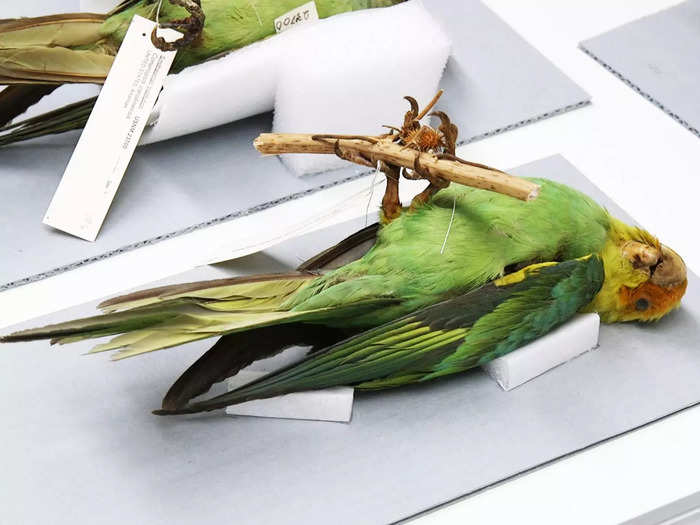
Extinct Carolina parakeets specimens, native to Washington D.C. or Maryland, at the Smithsonian. Nicole Raucheisen/Insider
The skins collection are birds with their insides removed. There are 2,000 specimen cases here, filled with bird skins stuffed with cotton.
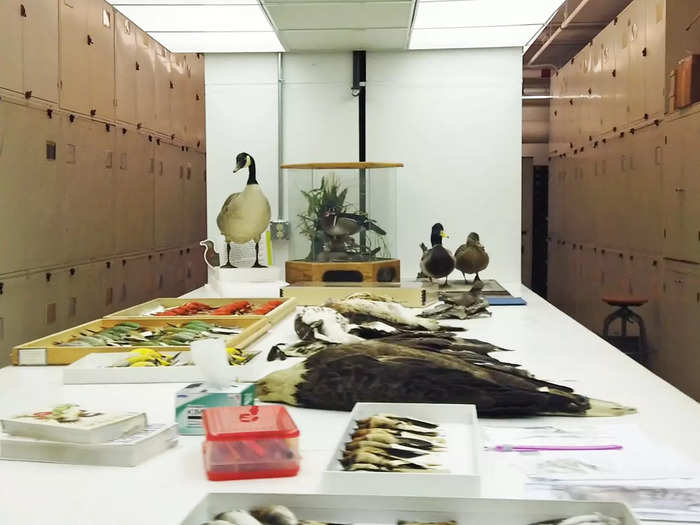
Drawers of bird specimens at the Smithsonian National Museum of Natural History. Michelle Yan Huang/Insider
This huge ostrich was a gift from King Menelik of Jordan to former President Theodore Roosevelt.
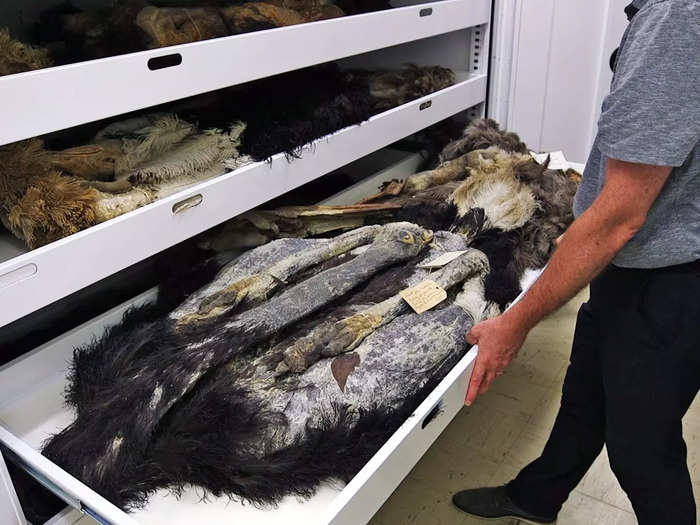
A male Somali ostrich in a drawer at the Smithsonian National Museum of Natural History. Michelle Yan Huang/Insider
This ostrich lived in the Smithsonian zoo until it died from old age in 1930. It was then donated for researchers to reference 92 years later.
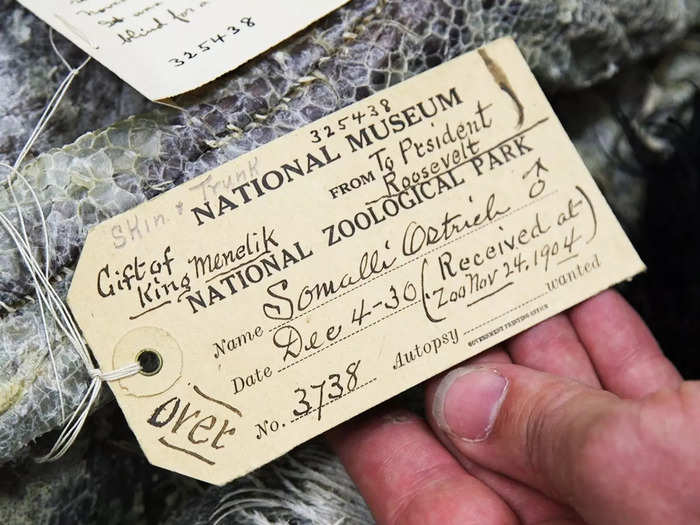
A tag with information about the Somali ostrich. Nicole Raucheisen/Insider
Roosevelt had his own natural history collection, which he donated to the Smithsonian in 1882. He even prepared his specimens.
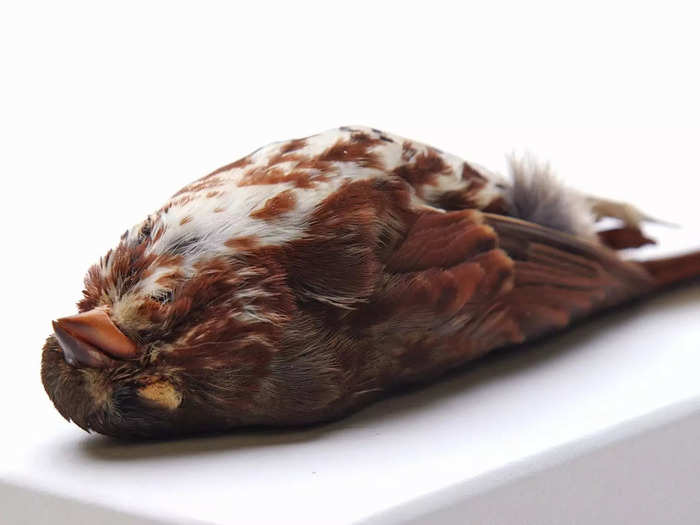
A fox sparrow that Roosevelt personally prepared in 1874. Nicole Raucheisen/Insider
The Smithsonian collection isn't just impressive in its diversity. It also has many of the same types of birds, like these macaws.
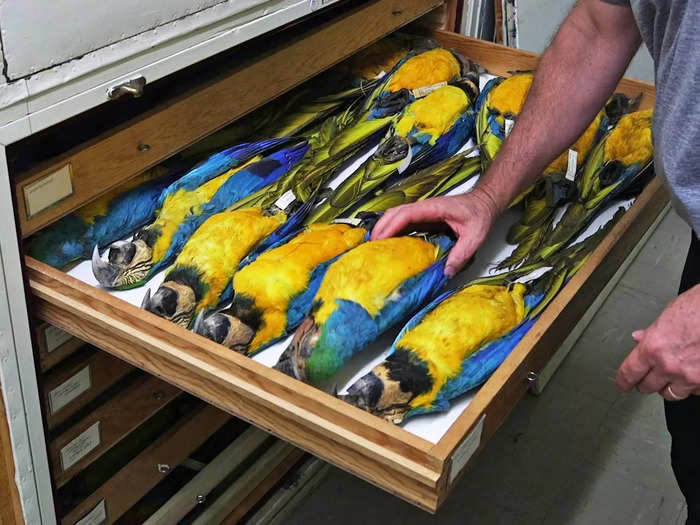
A drawer of blue-and-yellow macaw specimens in the skins collection. Michelle Yan Huang/Insider
The Smithsonian often keeps these birds in pristine condition — but researchers can cut an old specimen for scientific research, like genetic analysis.
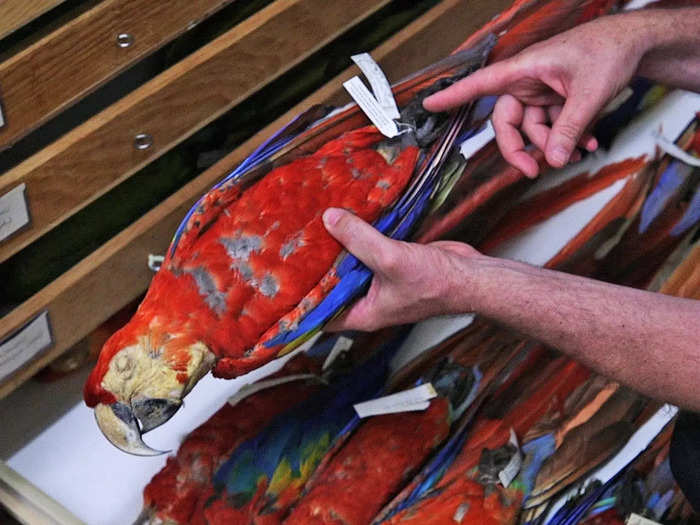
Scarlet macaw specimens at the Smithsonian National Museum of Natural History. Nicole Raucheisen/Insider
Specimens get a special label if that kind of work is done. A small sample can offer researchers the specimen’s entire genomic data.
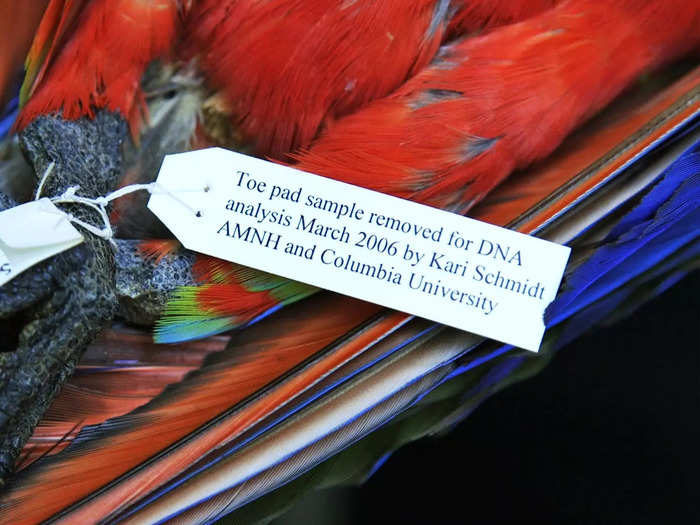
A tag that describes what has been done to the specimen for research. Nicole Raucheisen/Insider
One thing you’ll notice: These birds are missing their eyes. Since these aren’t for display, glass eyes aren’t needed to make them lifelike.

A toucan specimen at the Smithsonian National Museum of Natural History. Nicole Raucheisen/Insider
"Soft parts" like toucan bills fade as they dry out over time.
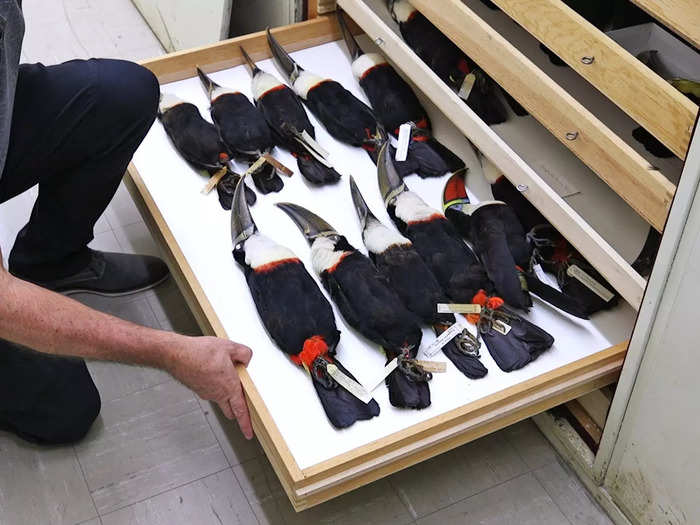
A drawer with a collection of toucans at the Smithsonian National Museum of Natural History. Michelle Yan Huang/Insider
The top toucan was taxidermied with glass eyes and a painted bill for an exhibit. The bottom toucan is a skins specimen for research.
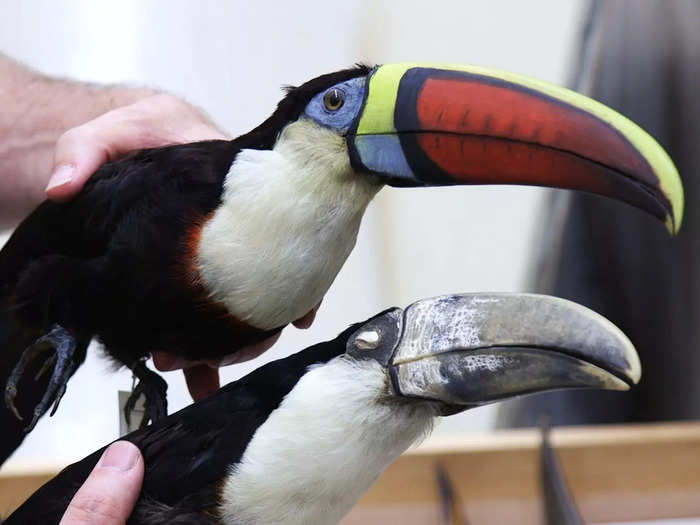
A taxidermied toucan and a toucan skin specimen at the Smithsonian National Museum of Natural History. Nicole Raucheisen/Insider
Sometimes, the museum only has a few rare birds. These passenger pigeons are one of the few species where we know the exact time of extinction: September 1, 1914, at 1 p.m.
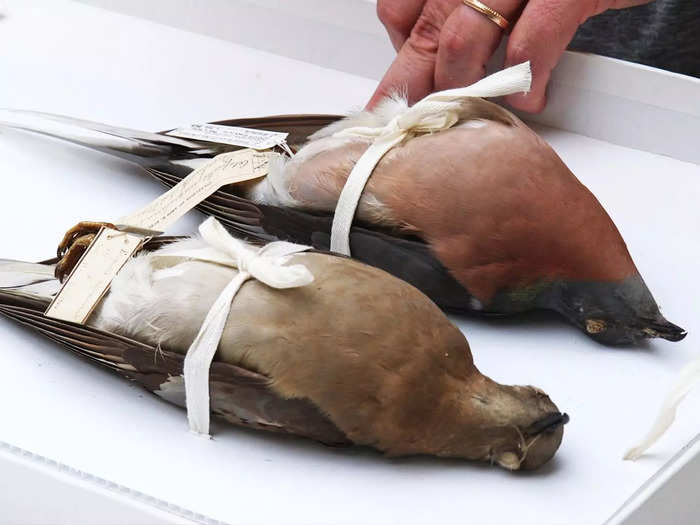
A male (top) and female (bottom) passenger pigeon at the Smithsonian National Museum of Natural History. Nicole Raucheisen/Insider
The last known passenger pigeon was a female at the Cincinnati Zoo; she's currently on display at the Smithsonian.
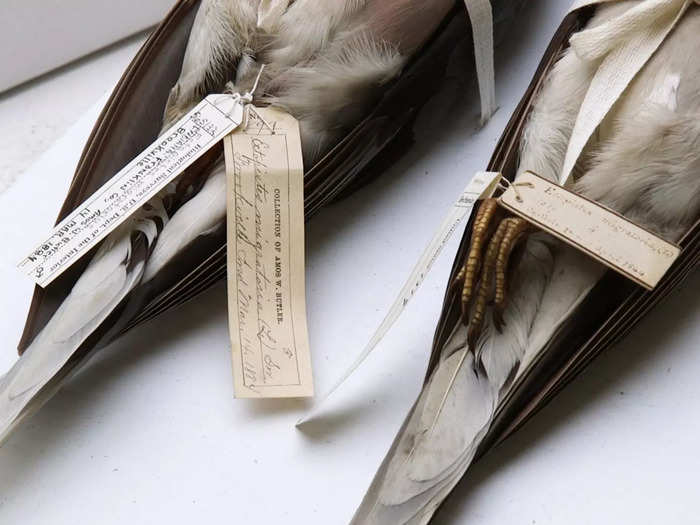
Close up of tags of the male and female passenger pigeon at the Smithsonian National Museum of Natural History. Nicole Raucheisen/Insider
But the museum aims to gather several of the same specimens for research, too, like these great grey owls.
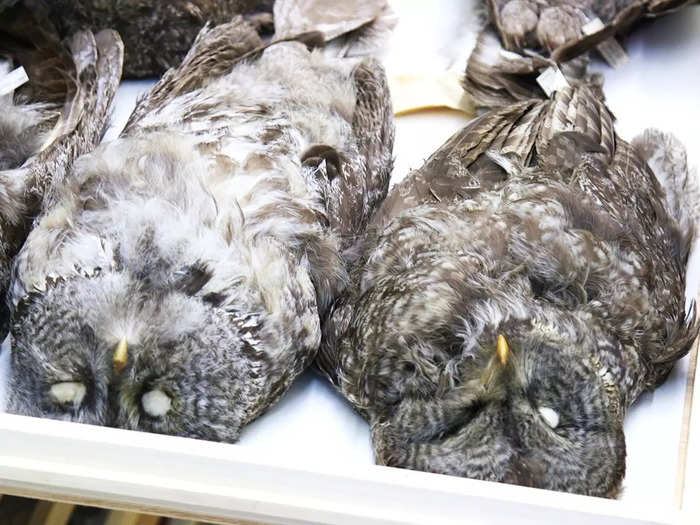
A drawer of great grey owl specimens at the Smithsonian National Museum of Natural History. Nicole Raucheisen/Insider
These are song sparrows from across the world. They're all genetically identical, but they're not the same size or color.

A row of song sparrows from around the world at the Smithsonian National Museum of Natural History. Nicole Raucheisen/Insider
The song sparrow on the left is from Arizona, and the one on the right is from the Aleutian islands in Alaska.
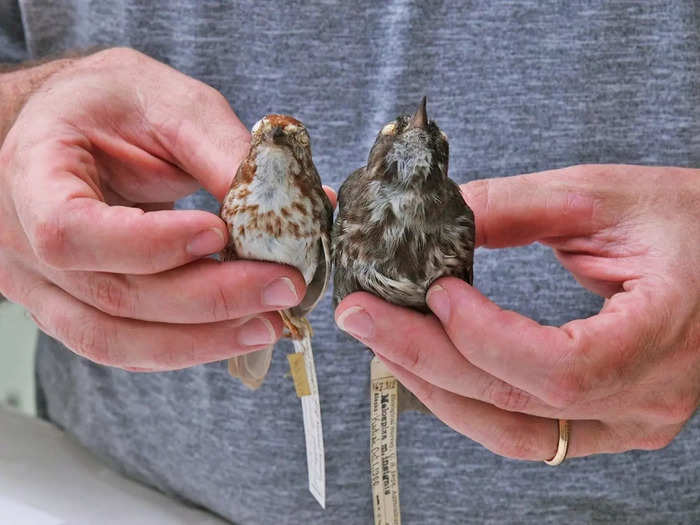
These two song sparrows from different parts of the world at the Smithsonian National Museum of Natural History. Nicole Raucheisen/Insider
Extensive collections are helpful for the Bird Identification Lab, which identifies birds killed from airplane strikes to help reduce accidents.
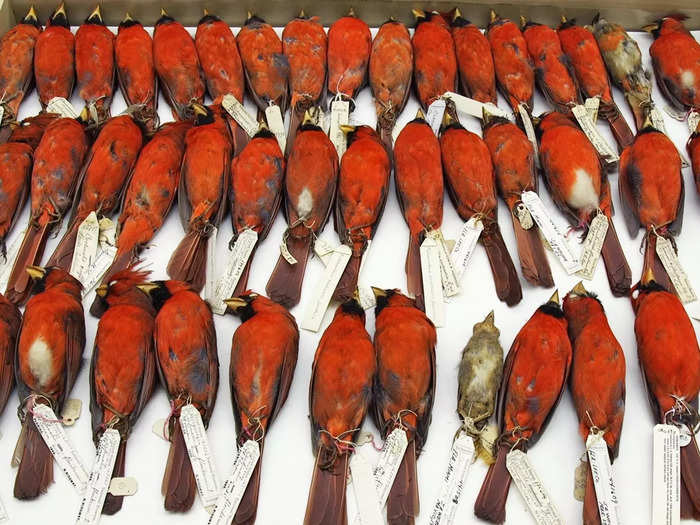
A drawer of cardinals at the Smithsonian National Museum of Natural History. A drawer of cardinals at the Smithsonian National Museum of Natural History.
The Lab typically gets about 10,000 samples per year, sometimes finding birds as small as these ruby-throated hummingbirds.
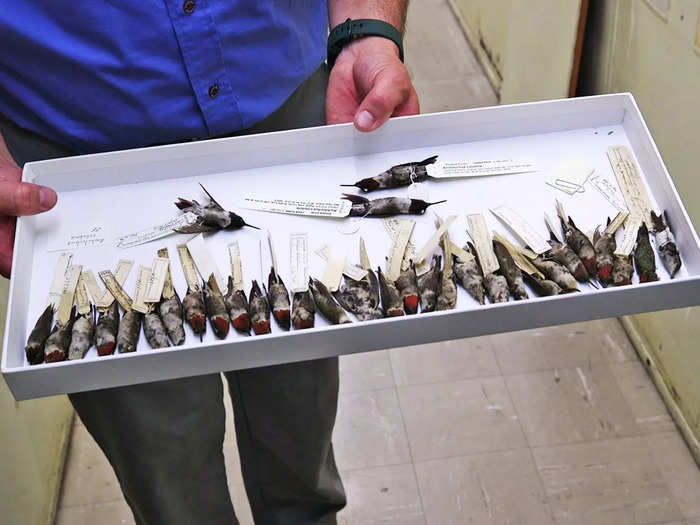
These ruby-throated hummingbirds may be small but they find the most expensive parts of planes. Michelle Yan Huang/Insider
The largest birds to get hit by airplanes have been bald eagles.
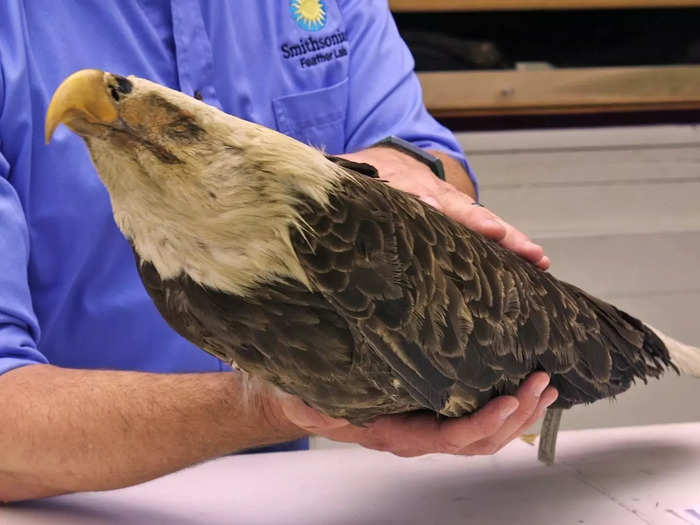
A bald eagle specimen being used by research assistant of the Feather Identification Lab team, Jim Whatton. Nicole Raucheisen/Insider
The most commonly hit birds in North America are ones attracted to grasslands, like meadowlarks. Their back feathers blend into the grass, making them harder to spot.
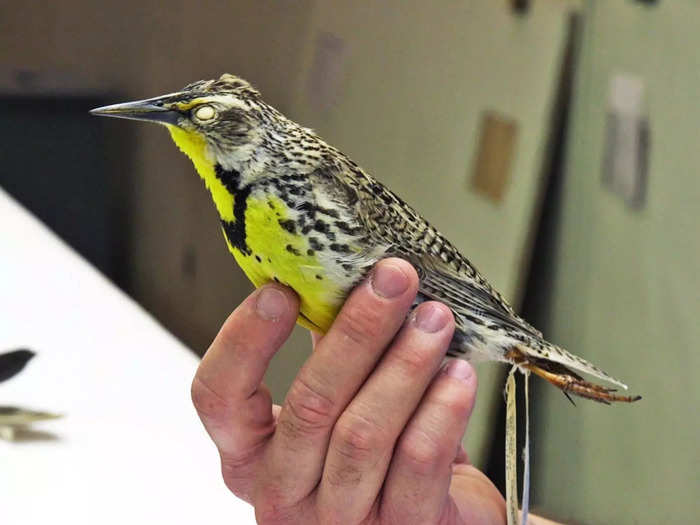
A meadowlark specimen at the Smithsonian National Museum of Natural History. Nicole Raucheisen/Insider
The team also found the most commonly hit birds overseas are the blue-cheeked bee-eaters.
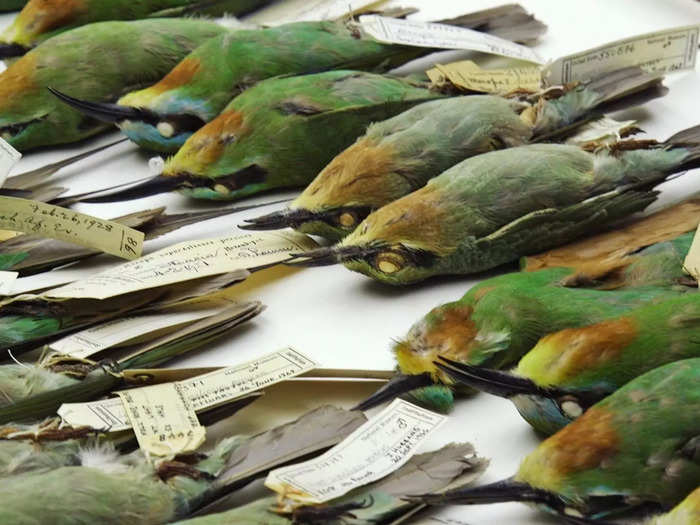
The Lab usually receives feather samples of blue-cheeked bee-eater birds from Asia and Europe. Nicole Raucheisen/Insider
To better identify birds, the lab can also reference wing specimens, which help researchers study a bird’s wing patterns more clearly.
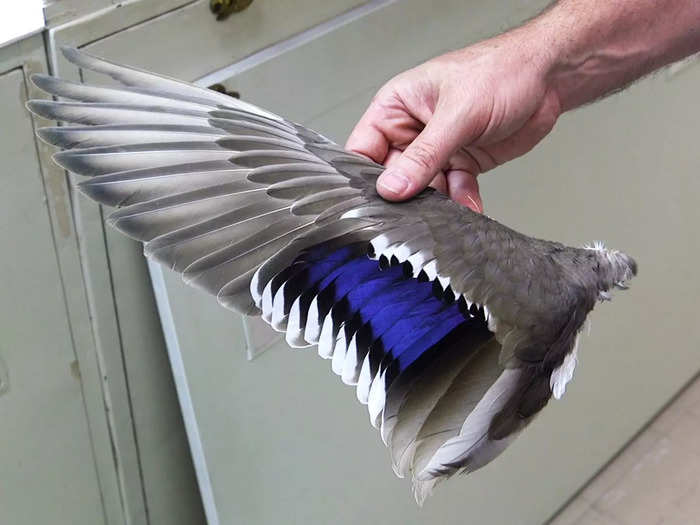
A wing specimen of a mallard at the Smithsonian National Museum of Natural History. Michelle Yan Huang/Insider
This wing is from an Amazon parrot. The feathers change colors as it moves in different light.
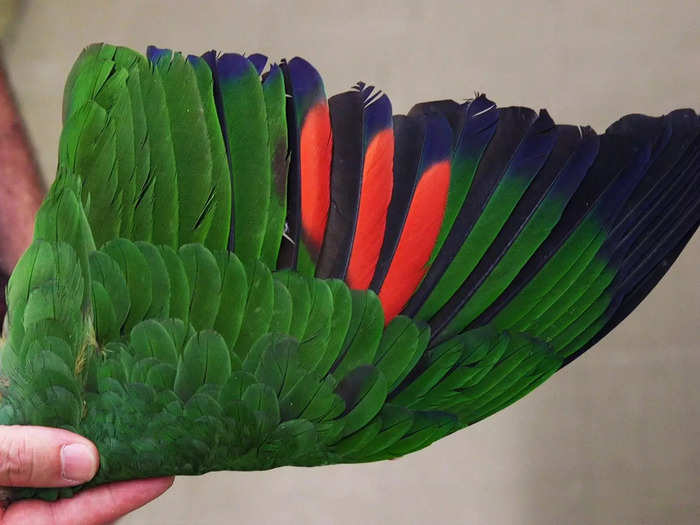
A wing specimen of an Amazon parrot at the Smithsonian National Museum of Natural History. Nicole Raucheisen/Insider
Many wings were received through partnerships with government agencies, like this California condor wing.
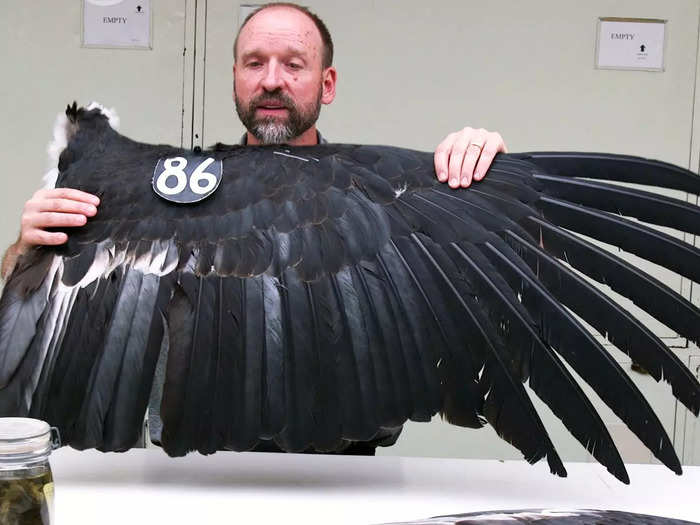
A wing specimen of a California condor at the Smithsonian National Museum of Natural History. Michelle Yan Huang/Insider
But the museum also tries to preserve the homes of birds. This oropendola bird and its nest is one of the biggest nests in the collection.
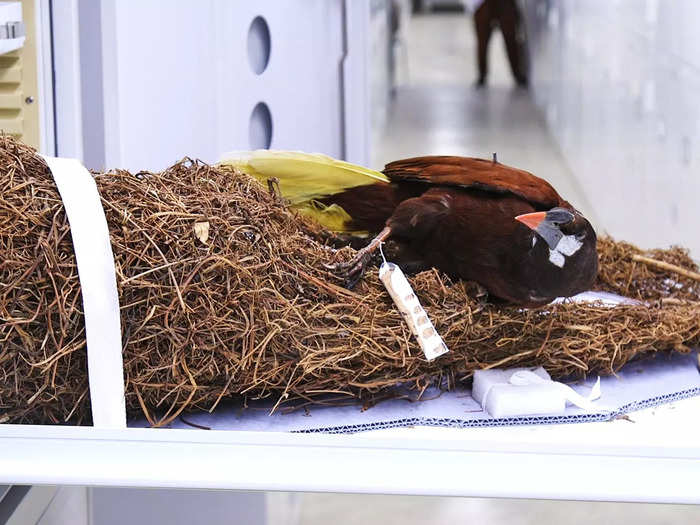
An oropendola bird and its nest in the nest collection at the Smithsonian National Museum of Natural History. Nicole Raucheisen/Insider
Oropendola birds are best known for making extravagant, teardrop-shaped nests that hang on top of trees.
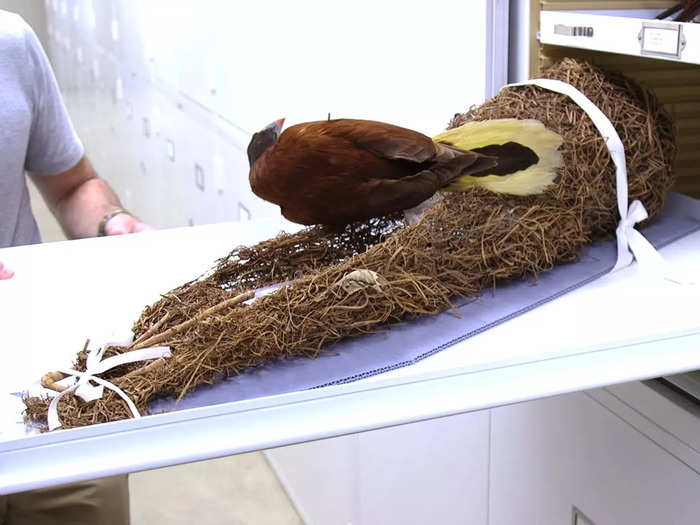
An oropendola bird specimen and its teardrop nest at the Smithsonian National Museum of Natural History. Michelle Yan Huang/Insider
All these specimens are timestamps of the present bird population and help create a record for future researchers.
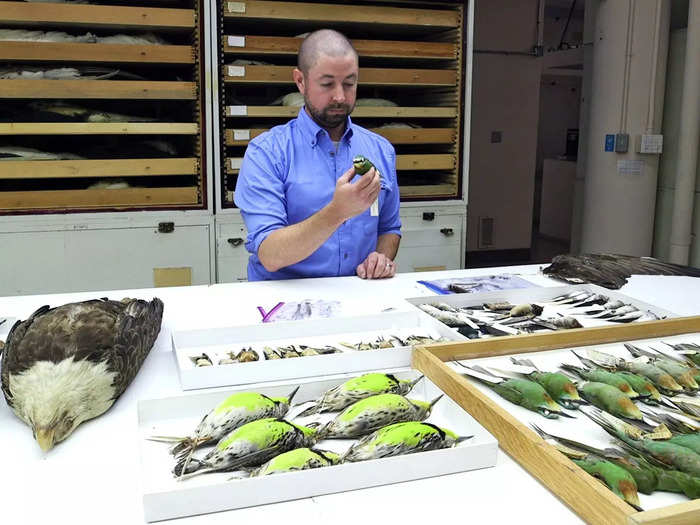
Whatton observing a blue-cheeked bee-eater specimen that he personally prepared. Michelle Yan Huang/Insider
Popular Right Now
Popular Keywords
Advertisement